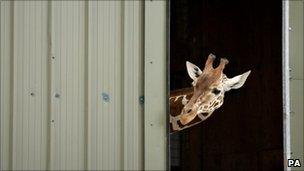Who, what, why: Are giraffes more at risk from lightning?
- Published

The death this week of a giraffe struck by lightning raises an obvious question: are these lankiest of creatures especially vulnerable to bolts from the sky?
Hamley the giraffe's death in a South African game reserve has been widely reported as he's been a fixture in the ITV drama Wild At Heart.
Was he unlucky - wrong place, wrong time, wrong weather conditions - or are giraffes regularly hit by lightning?
When a bolt strikes, the instinct is to duck. Pity the poor giraffe. Standing about 5m tall thanks to its elongated neck and lanky legs, it is the tallest land-living animal. So it's easy to see why giraffa camelopardalis might attract lightning.
Dr Julian Fennessy, a Namibia-based conservationist and chair of the International Giraffe Working Group, says such deaths are not unknown.
"I can think of a number of cases where a giraffe has been killed by lightning, both from a direct hit and by being struck by a tree that it was standing beneath.
"But it is still quite rare. As they say, lightning doesn't usually strike twice. Hazarding a guess, we have one or two cases a year."
Some science blogs argue that it is not just the giraffe's height, but the greater distance between its legs that make it more likely for electric current to flow to the animal when lightning strikes. Others reject this view.
And Wikipedia, external suggests that giraffes in zoos are at particular risk as "they are typically the tallest objects in a zoo. In the wild, this hazard is reduced by the presence of trees. As well, the giraffe's natural habitat range has an extremely low occurrence of lightning."
In 2003, a giraffe named Betsy died in Florida's Walt Disney World after reportedly being struck by lightning. But are those in captivity really more at risk?

Giraffes take shelter in storms
Sarah Forsyth, curator of Colchester Zoo which has three giraffes, says it is extremely rare for giraffes to perish in this way. Giraffes dislike bad weather, so those in captivity take shelter inside during storms.
"I've not heard of one being struck by lightning before. I know about cases of elephants being struck in the wild - although I guess the giraffe being tall is an issue because lightning will be attracted to tall things."
While a giraffe might be the tallest object on the African plain, in zoos there tend to be buildings that top this height, she adds.
Because of the improbability of being hit, the giraffe is at no appreciably greater risk than other species, says Dr Fennessy. Last year in Scotland, 16 bullocks were killed after a lightning strike. Reports suggested the animals were huddled together when one was hit, and the current was conducted through a puddle to the others.
"If you're in the wrong place at the wrong time you're susceptible - it's not that giraffes stand out like lightning rods," says Dr Fennessy. "I know of a sad incident where a pack of wild dogs were sheltering under a tree that was struck and all of them died."
The real threat faced by giraffes is not from lightning strikes but from man, he says, with numbers "plummeting" in parts of Africa because of habitat loss and increased poaching.
Unlike elephants and big cats, giraffes are little understood or researched, he says, yet there's a magic to their unique morphology.
"Spotting one in the wild is like seeing an animal at the far edge of evolution. It can look like the most clumsy and the most graceful animal all at once."